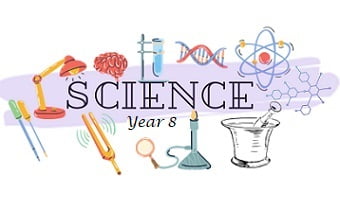Science for Year 8
School Education divided into 13 grade levels. Each grade level has certain standards for different skills. Teacher’s job is to detect students’ real year level and her/his needs to continue her/his academic development.
A comprehensive set of progressive learning objectives for science year 8. The objectives detail what the learner should know or what they should be able to do in science in year 8 of primary education.
E Scientific enquiry
Ep Ideas and evidence
• 8Ep1 Discuss the importance of developing empirical questions which can be investigated, collecting evidence, developing explanations and using creative thinking.
• 8Ep2 Test predictions with reference to evidence gained.
Ep Plan investigative work
• 8Ep3 Select ideas and turn them into a form that can be tested.
• 8Ep4 Plan investigations to test ideas.
• 8Ep5 Identify important variables; choose which variables to change, control and measure.
• 8Ep6 Make predictions using scientific knowledge and understanding.
Eo Obtain and present evidence
• 8Eo1 Take appropriately accurate measurements.
• 8Eo2 Use a range of equipment correctly.
• 8Eo3 Discuss and control risks to themselves and others.
• 8Eo4 Present results as appropriate in tables and graphs.
Ec Consider evidence and approach
• 8Ec1 Make simple calculations.
• 8Ec2 Identify trends and patterns in results (correlations).
• 8Ec3 Compare results with predictions.
• 8Ec4 Identify anomalous results and suggest improvements to investigations.
• 8Ec5 Interpret data from secondary sources.
• 8Ec6 Discuss explanations for results using scientific knowledge and understanding. Communicate these clearly to others.
• 8Ec7 Present conclusions to others in appropriate ways.
B Biology
Bp Plants
• 8Bp1 Explore how plants need carbon dioxide, water and light for photosynthesis in order to make biomass and oxygen.
• 8Bp2 Describe the absorption and transport of water and mineral salts in flowering plants.
Bh Humans as organisms
• 8Bh1 Identify the constituents of a balanced diet and the functions of various nutrients. Secondary sources can be used.
• 8Bh2 Understand the effects of nutritional deficiencies.
• 8Bh3 Recognise the organs of the alimentary canal and know their functions. Secondary sources can be used.
• 8Bh4 Understand the function of enzymes as biological catalysts in breaking down food to simple chemicals.
• 8Bh5 Recognise and model the basic components of the circulatory system and know their functions.
• 8Bh6 Understand the relationship between diet and fitness.
• 8Bh7 Discuss how conception, growth, development, behaviour and health can be affected by diet, drugs and disease.
• 8Bh8 Recognise the basic components of the respiratory system and know their functions.
• 8Bh9 Define and describe aerobic respiration, and use the word equation.
• 8Bh10 Explain gaseous exchange.
• 8Bh11 Describe the effects of smoking. Secondary sources can be used.
• 8Bh12 Discuss the physical and emotional changes that take place during adolescence.
• 8Bh13 Describe the human reproductive system, including the menstrual cycle, fertilisation and foetal development.
C Chemistry
Cs States of matter
• 8Cs1 Show how the particle theory of matter can be used to explain the properties of solids, liquids and gases, including changes of state, gas pressure and diffusion.
Cp Material properties
• 8Cp1 Describe and explain the differences between metals and non-metals.
• 8Cp2 Give chemical symbols for the first twenty elements of the Periodic Table.
• 8Cp3 Understand that elements are made of atoms.
• 8Cp4 Explain the idea of compounds.
• 8Cp5 Name some common compounds including oxides, hydroxides, chlorides, sulfates and carbonates.
• 8Cp6 Distinguish between elements, compounds and mixtures.
Cc Material changes
• 8Cc1 Use a word equation to describe a common reaction. Secondary sources can be used.
• 8Cc2 Describe chemical reactions which are not useful, e.g. rusting.
P Physics
Pf Forces and motion
• 8Pf1 Calculate average speeds, including through the use of timing gates.
• 8Pf2 Interpret simple distance/time graphs.
Ps Sound
• 8Ps1 Explain the properties of sound in terms of movement of air particles.
• 8Ps2 Recognise the link between loudness and amplitude, pitch and frequency, using an oscilloscope.
Pl Light
• 8Pl1 Use light travelling in a straight line to explain the formation of shadows and other phenomena.
• 8Pl2 Describe how non-luminous objects are seen.
• 8Pl3 Describe reflection at a plane surface and use the law of reflection.
• 8Pl4 Investigate refraction at the boundary between air and glass or air and water.
• 8Pl5 Explain the dispersion of white light.
• 8Pl6 Explain colour addition and subtraction, and the absorption and reflection of coloured light.
Pm Magnetism
• 8Pm1 Describe the properties of magnets.
• 8Pm2 Recognise and reproduce the magnetic field pattern of a bar magnet.
• 8Pm3 Construct and use an electromagnet.
If you are thinking to take in a small group (2-3 people) OR
Do you have any question? Please





Reviews
There are no reviews yet.